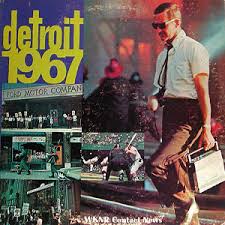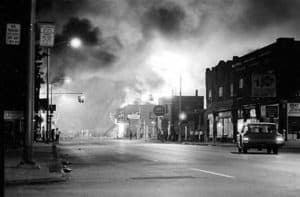It began with a raid on an unlicensed after hours bar, “a blind pig” in the parlance of that time. 5 days later 43 had died, nearly 1,200 were injured, over 2,000 buildings had burned and more than 7,000 were arrested. It became known as the 1967 12th Street Riot (#Rebellion67 is the hash tag being used on Twitter), at the time the largest riot since the Civil War. It would not be surpassed until 1992 when Los Angeles erupted in the wake of the Rodney King beating.
Units of the Michigan Army National Guard and ultimately the 82nd and 101st Airborne Divisions were deployed to quell the unrest and the reverberations of the event still echo to the present day.
 WKNR Contact News provided extensive coverage of the story, which featured prominently in Keener’s annual documentary production, “Detroit 1967“.
WKNR Contact News provided extensive coverage of the story, which featured prominently in Keener’s annual documentary production, “Detroit 1967“.
News Director Philip Nye deployed WKNR’s 8 man staff throughout the impacted area. “At it’s peak,” he remembered, “the riots spread over fourteen-square miles of the city. A curfew was in effect, a complete ban placed on liquor sales, gasoline can be purchased only during certain hours and never in a container, offices, banks, schools, businesses, industries were closed down; the heart of Detroit was deserted. Deliveries were curtailed. Food ran short. All normal activities in the nation’s fifth-largest city was at a standstill.”
“Police sealed off 12 street hoping to contain the riot. It didn’t work. All available firemen were called to duty, trying to battle the burgeoning number of blazes. It became nearly an impossible task. Time after time they were the targets of bricks and bottles at a fire scene. Later those bricks and bottles became bullets. Like a plague it spread, moving west and northwest across Woodward. It was out of control. At a command post downtown, city officials were joined by Michigan Gov. Romney. State police were called in, the National Guard mobilized and finally federal troops requested… By Thursday, it had run its course. Troops were told that sheathe their bayonets. On Friday the last major fire was reported.”

The Detroit Free Press won a 1968 Pulitzer Prize for it’s coverage and many of us who listened to WKNR back in the day remember visceral television images of black smoke curling into the summer sky.
Much was done in the wake of the riot to try and change the environment of anger and distrust. The success of initiatives like “New Detroit” and “Detroit Renaissance” are debated to this day.
In 1994, Detroit’s first African American mayor, Coleman Young, would write, “The heaviest casualty, however, was the city. Detroit’s losses went a hell of a lot deeper than the immediate toll of lives and buildings. The riot put Detroit on the fast track to economic desolation, mugging the city and making off with incalculable value in jobs, earnings taxes, corporate taxes, retail dollars, sales taxes, mortgages, interest, property taxes, development dollars, investment dollars, tourism dollars, and plain damn money. The money was carried out in the pockets of the businesses and the white people who fled as fast as they could. The white exodus from Detroit had been prodigiously steady prior to the riot, totaling twenty-two thousand in 1966, but afterwards it was frantic. In 1967, with less than half the year remaining after the summer explosion—the outward population migration reached sixty-seven thousand. In 1968 the figure hit eighty-thousand, followed by forty-six thousand in 1969.”
The summer of ’67 changed the nation, bringing uncomfortable realities to the forefront of our consciousness and changing the course of our dialogue about race, poverty and the American Dream forever.
Link – Listen to Detroit ‘ 67, the WKNR Contact News documentary about the year.
Link – Read Jim Feliciano’s excellent essay about the 12th Street Riot and WKNR’s coverage at the Motor City Radio Flashbacks website.
 Michigan Radio’s Stateside program is tweeting the events of #Rebellion67 in real time on twitter. Follow @StatesideRadio for the stream.
Michigan Radio’s Stateside program is tweeting the events of #Rebellion67 in real time on twitter. Follow @StatesideRadio for the stream.


